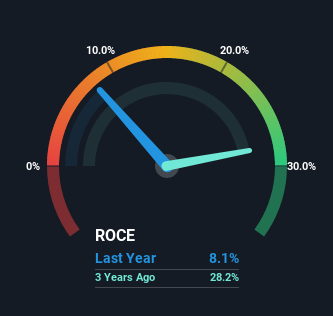- Saudi Arabia
- /
- Food
- /
- SASE:2281
There Are Reasons To Feel Uneasy About Tanmiah Food's (TADAWUL:2281) Returns On Capital
What trends should we look for it we want to identify stocks that can multiply in value over the long term? Firstly, we'd want to identify a growing return on capital employed (ROCE) and then alongside that, an ever-increasing base of capital employed. If you see this, it typically means it's a company with a great business model and plenty of profitable reinvestment opportunities. However, after briefly looking over the numbers, we don't think Tanmiah Food (TADAWUL:2281) has the makings of a multi-bagger going forward, but let's have a look at why that may be.
What Is Return On Capital Employed (ROCE)?
For those who don't know, ROCE is a measure of a company's yearly pre-tax profit (its return), relative to the capital employed in the business. The formula for this calculation on Tanmiah Food is:
Return on Capital Employed = Earnings Before Interest and Tax (EBIT) ÷ (Total Assets - Current Liabilities)
0.081 = ر.س60m ÷ (ر.س1.6b - ر.س812m) (Based on the trailing twelve months to June 2022).
Thus, Tanmiah Food has an ROCE of 8.1%. On its own that's a low return, but compared to the average of 6.0% generated by the Food industry, it's much better.
Check out the opportunities and risks within the SA Food industry.

In the above chart we have measured Tanmiah Food's prior ROCE against its prior performance, but the future is arguably more important. If you'd like to see what analysts are forecasting going forward, you should check out our free report for Tanmiah Food.
What Can We Tell From Tanmiah Food's ROCE Trend?
When we looked at the ROCE trend at Tanmiah Food, we didn't gain much confidence. Over the last three years, returns on capital have decreased to 8.1% from 28% three years ago. Although, given both revenue and the amount of assets employed in the business have increased, it could suggest the company is investing in growth, and the extra capital has led to a short-term reduction in ROCE. If these investments prove successful, this can bode very well for long term stock performance.
On a related note, Tanmiah Food has decreased its current liabilities to 52% of total assets. That could partly explain why the ROCE has dropped. What's more, this can reduce some aspects of risk to the business because now the company's suppliers or short-term creditors are funding less of its operations. Some would claim this reduces the business' efficiency at generating ROCE since it is now funding more of the operations with its own money. Either way, they're still at a pretty high level, so we'd like to see them fall further if possible.
The Key Takeaway
Even though returns on capital have fallen in the short term, we find it promising that revenue and capital employed have both increased for Tanmiah Food. Furthermore the stock has climbed 29% over the last year, it would appear that investors are upbeat about the future. So while investors seem to be recognizing these promising trends, we would look further into this stock to make sure the other metrics justify the positive view.
Tanmiah Food does have some risks, we noticed 4 warning signs (and 3 which are potentially serious) we think you should know about.
For those who like to invest in solid companies, check out this free list of companies with solid balance sheets and high returns on equity.
Valuation is complex, but we're here to simplify it.
Discover if Tanmiah Food might be undervalued or overvalued with our detailed analysis, featuring fair value estimates, potential risks, dividends, insider trades, and its financial condition.
Access Free AnalysisHave feedback on this article? Concerned about the content? Get in touch with us directly. Alternatively, email editorial-team (at) simplywallst.com.
This article by Simply Wall St is general in nature. We provide commentary based on historical data and analyst forecasts only using an unbiased methodology and our articles are not intended to be financial advice. It does not constitute a recommendation to buy or sell any stock, and does not take account of your objectives, or your financial situation. We aim to bring you long-term focused analysis driven by fundamental data. Note that our analysis may not factor in the latest price-sensitive company announcements or qualitative material. Simply Wall St has no position in any stocks mentioned.
About SASE:2281
Tanmiah Food
Engages in food and agriculture business in Saudi Arabia and internationally.
Reasonable growth potential with slight risk.
Market Insights
Community Narratives





